1965 marked a significant turning point for U.S. coinage. Due to a sharp rise in silver prices, widespread hoarding of coins led to a nationwide shortage. Although pennies didn’t contain any silver, people still began saving them out of habit during this economic shift.
To address the situation, the Mint changed the composition of many coins, introducing what’s known as the “Johnson Sandwich”—a layered mix of cheaper metals. While the penny’s metal content remained the same, it was still affected by the broader changes in circulation and production policies.
1965 Penny Value Chart
| Coin Type | MS/SP 60 | MS/SP 63 | MS/SP 65 | MS/SP 67 |
|---|---|---|---|---|
| 1965 No Mint Mark Penny (Red) | – | $5 | $18 | $425 |
| 1965 SMS Satin Finish Penny (Red) | $2 | $6 | $14 | $46 |
History of the 1965 Penny

From its earliest days, the U.S. Mint used precious metals like gold and silver, alongside copper, to produce coins. Gold and silver, known as specie metals, are relatively soft, so the Mint added copper to strengthen them—typically 1% for gold coins and 10% for silver. But as silver became more expensive, the amount of copper increased significantly, reaching up to 60%.
Copper itself is tougher than gold and silver, but still not particularly durable. To make copper coins more resilient, the Mint occasionally blended in other metals such as nickel or zinc. And since metal values tend to fluctuate over time, the Mint would sometimes alter a coin’s size to keep its production cost aligned with its face value. This happened in 1856, when the Large Cent (28.5mm) was replaced by the Small Cent (19mm).
The 1965 Lincoln cent was one of these Small Cents, featuring the Lincoln Memorial reverse introduced in 1959 to commemorate the 150th anniversary of Lincoln’s birth. This design remained in use until 2008, ahead of the special Bicentennial designs in 2009. However, 1965 was significant for another reason as well.
The Phase-Out of Silver in U.S. Coinage
In 1965, the Mint began phasing out silver from circulating coins. Dimes and quarters transitioned from 90% silver to a clad composition, consisting of a pure copper core with outer layers made of 75% copper and 25% nickel—the same alloy used for nickels. Half dollars kept some silver (40%) until 1970 before being fully converted to clad as well.
This shift happened because the rising price of silver led to hoarding and melting of coins, creating a severe shortage and major losses for the Mint. While silver was the main concern, pennies—even though they didn’t contain silver—were also hoarded due to the overall scarcity.
To combat this issue, Mint Director Eva Adams blamed collectors for the shortage and recommended removing mint marks from coins, making them less appealing to numismatists. This no mint mark policy lasted from 1965 to 1967.
Special Mint Sets and Satin Finishes
During this time, the Mint also suspended the production of proof coins, which had traditionally been made for collectors. To fill the gap, they released Special Mint Sets (SMS) in 1965, which had a similar appearance to proofs but were produced differently.
Unlike proof coins, where the coin blanks were polished with steel beads (a process called burnishing) and struck multiple times for a mirror-like finish, the 1965 SMS coins used unpolished blanks. They were struck only once, but with higher pressure, resulting in a clean, satin-like finish. These coins are known in grading as SMS or SP (Specimen Strikes).
Date Confusion and Mint Activity
Due to hoarding and a backlog in coin distribution, the Mint froze the date on pennies and quarters at 1964 until 1966. As a result, many coins marked 1964 were actually minted in the years that followed. For instance, although the official date is 1965, only about one million of the 1965 pennies were actually minted that year—the rest came off the presses in 1966.
Another noteworthy development was the reopening of the San Francisco Mint in 1965 after being inactive for a decade. This facility eventually became the dedicated site for producing proof coins due to its superior striking quality and attention to detail. Its specialization also led to fewer minting errors, making its output more reliable for collectors.
Characteristics of the 1965 Penny
Coins begin as flat metal discs known as planchets. The front, or heads side, is called the obverse, while the back, or tails side, is known as the reverse. The narrow part around the coin is referred to as the edge, and the slightly raised border along the edge is called the rim or collar. Some coins feature small grooves along the edge, known as reeds.
The main image or portrait on a coin is known as the device, while the written elements are called legends or mottos. The flat surface area behind the image and text is called the field.
The Obverse of the 1965 Penny

The obverse of the coin features Abraham Lincoln, the 16th President of the United States, shown in a right-facing profile. Above his head is the national motto “In God We Trust,” while the word “Liberty” appears behind his image. Lincoln is depicted wearing a jacket and bow tie.
To the right of his chest, you’ll find the year of minting, and just beneath the date is the mint mark, if present. On the shoulder cutoff of the portrait, the initials “VDB” can be seen—these stand for Victor David Brenner, the artist who designed the coin.
The Reverse of the 1965 Penny
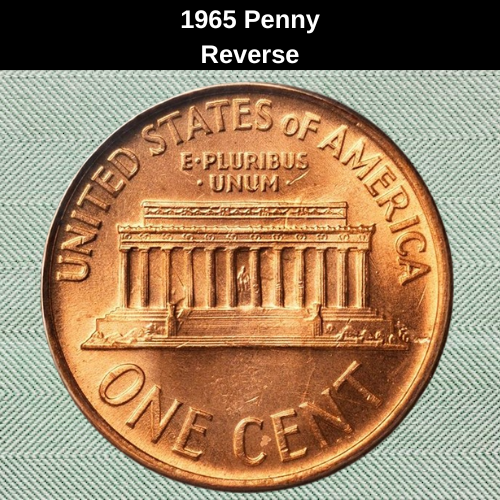
The reverse of the coin displays the Lincoln Memorial, and if you look closely through the central columns, you’ll spot the seated statue of Abraham Lincoln inside. On the lower right side of the memorial steps are the initials “FG”, representing the designer Frank Gasparro.
The top edge of the coin is inscribed with “United States of America”, and just below that is the Latin phrase “E Pluribus Unum”, with dots on either side of “Unum.” Along the bottom rim, the denomination is clearly written as “One Cent.”
Additional Details About the 1965 Penny
The 1965 Lincoln penny features a smooth, unreeded edge, typical of cents from this era. It measures 19.05 millimeters (0.75 inches) in diameter and has a weight of 3.11 grams. The composition is primarily 95% copper and 5% zinc.
Even though only a portion of the coins dated 1965 were actually minted during that year, there’s no visible way to distinguish them. Only the official minting records can confirm the exact time and place each of these one-cent coins was produced.
Grading the 1965 Penny
Coins are evaluated using the Sheldon Grading Scale, which ranges from 1 (Poor) to 70 (Perfect Mint State). Since no proof versions of the 1965 penny were produced, you won’t find any graded as PR (Proof) or PF. Instead, special satin finish coins from that year are marked as SP (Specimen) or SMS (Special Mint Set).
For copper coins like the 1965 penny, color classification is also important:
- RD (Red) for coins that retain at least 95% of their original red luster.
- RB (Red-Brown) for those with a mix of red and brown tones.
- BN (Brown) or BRN for coins that have turned mostly brown—this is the least valuable category.
Coin Grading Scale Overview:
| Grade | Description |
|---|---|
| 1 | Basal State |
| 2 | Fair |
| 3 | Very Fair |
| 4–6 | Good |
| 7–10 | Very Good |
| 12–15 | Fine |
| 20–30 | Very Fine |
| 40 | Extremely Fine |
| 50 | About Uncirculated |
| 60 | Mint State |
| 65 | Choice Mint State |
| 70 | Perfect Mint State |
Be sure to consult a reliable coin grading reference or guide to determine where your 1965 penny fits. Knowing the exact grade and color is crucial when estimating its market value.
1965 Penny Value Guides
Typically, a coin’s value is determined by factors like the mint branch where it was struck and its rarity. However, since all 1965 pennies lack mint marks, their value is primarily based on their condition.
In 1965, the U.S. Mint produced Business Strikes (also called Regular Strikes) at all three mint facilities: Philadelphia, Denver, and San Francisco. These were the coins that were intended for everyday circulation. On the other hand, Satin Finish coins were only minted in San Francisco as part of the Special Mint Set (SMS) process. These coins were struck with extra pressure to give them a satin-like finish and were aimed at collectors rather than for general circulation.
1965 No-Mint-Mark Penny Value
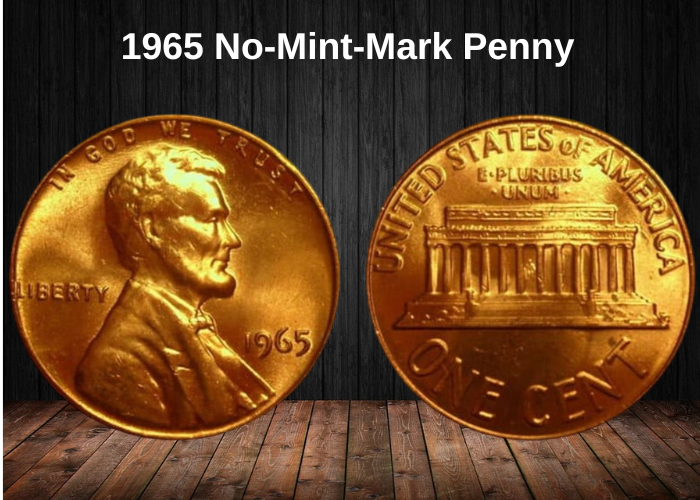
The total mintage of 1965 pennies was an impressive 1,494,864,900, but none of them carried mint marks. The breakdown of their production is as follows:
- Philadelphia Mint: 301,470,000 coins were made, but only 1,085,000 were minted in 1965; the rest were made in 1966.
- Denver Mint: 973,364,900 coins were made, all in 1966 despite being dated 1965.
- San Francisco Mint: 220,030,000 coins were made, all struck in 1966.
The value of these coins can vary greatly depending on the grade. In the past, some sales have shown notable prices for higher-grade coins:
- May 1, 2009: An MS 62 BN (Brown) 1965 penny sold for $633.
- January 19, 2012: An MS 67 RB (Red-Brown) coin went for $690.
- January 8, 2014: A high-grade MS 67 RD (Red) sold for $7,638.
However, the value has dropped somewhat in recent years. Currently, an MS 67 RD penny is valued at around $425, but 33 such coins have been certified by the PCGS. Moreover, there are only three MS 67+ examples known, and these are estimated to be worth about $4,000.
1965 Satin Finish SMS Penny Value
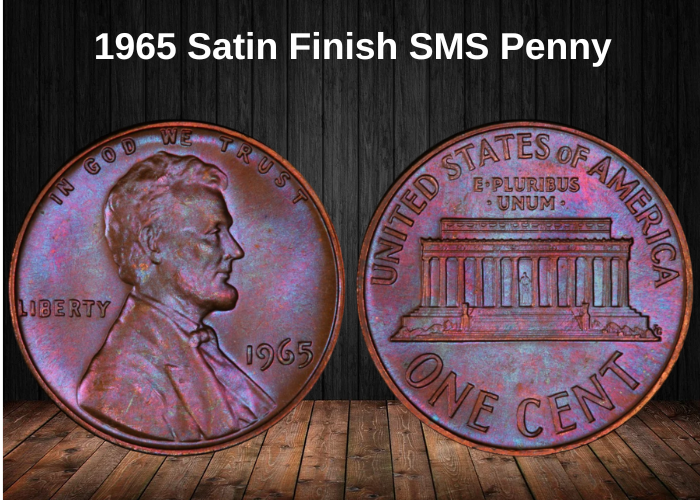
The San Francisco Mint produced 2,360,000 Satin Finish Pennies dated 1965, but they were all minted in 1966. These coins, which had no mint marks, are often considered more valuable due to their distinct satin finish.
Here are some notable sales for Satin Finish Pennies:
- SP 66 BN (Brown): Sold for $250 in 2020.
- SP 67 RB (Red-Brown): Sold for $260 in 2016.
- SP 68 RD (Red): Sold for $2,990 in 2009.
- SP 68 CAM (Cameo): Sold for $1,725 in 2018.
- SP 67 DCAM (Deep Cameo): Sold for $4,140 in 2004.
Rare 1965 Penny Errors List
While pennies and nickels today have a higher production cost than their face value, older coins, especially those with mint errors, can still be valuable for individual investors. Here are some common 1965 Penny Errors and their resale prices:
1965 Penny Mirrored Obverse Die Cap Error
A die cap error occurs when a planchet (the disc of metal that is struck to make a coin) becomes stuck on the die. This causes the planchet to act like a cap, blocking the striking of subsequent coins. The result is that the coin below may have a distorted or incomplete image, a sunken appearance, or sometimes a cupped shape.
In the case of a 1965 penny with a die cap error, the coin may show some striking issues:
- The obverse (front) could be properly struck, but the reverse (back) might have an incomplete image or might be blank or sunken.
- Another type of die cap error might result in the obverse design bleeding through the reverse side due to the obstruction caused by the die cap.
In higher grades, such as MS65 RD (Mint State 65 Red), these die cap errors are highly collectible. As an example, a 1965 penny with a die cap error was sold for $1,800 when graded MS65 RD. The rarity of the error and the excellent grade make it particularly valuable.
1965 Penny Broadstruck Wheel Mark Error
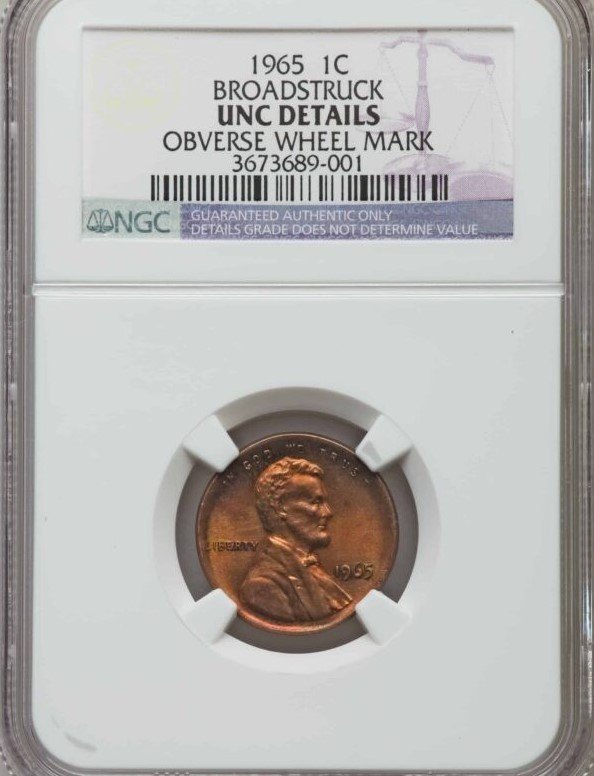
A broadstrike occurs when a coin is struck without the usual collar that holds it in place during the minting process. This collar is responsible for shaping the coin’s rim, maintaining its diameter, thickness, and overall metal content, which is essential for its value.
When the collar mold comes off too soon or is absent altogether, the coin is not properly confined during striking. As a result, the coin can spread out, losing its defined shape and becoming thinner on one side. The rim also may not form properly, leading to a wider and more irregular coin.
In terms of grading, a coin with a broadstrike error may not necessarily have high value unless it is in mint condition or has other rare features. For example, a broadstrike 1965 penny with Uncirculated Details might only fetch around $20.
The value is generally low because broadstrikes are not exceedingly rare, especially in lower-grade examples. However, in higher grades or with additional errors, a broadstrike coin could be worth more.
1965 Penny Double Struck Broadstruck Off-Center
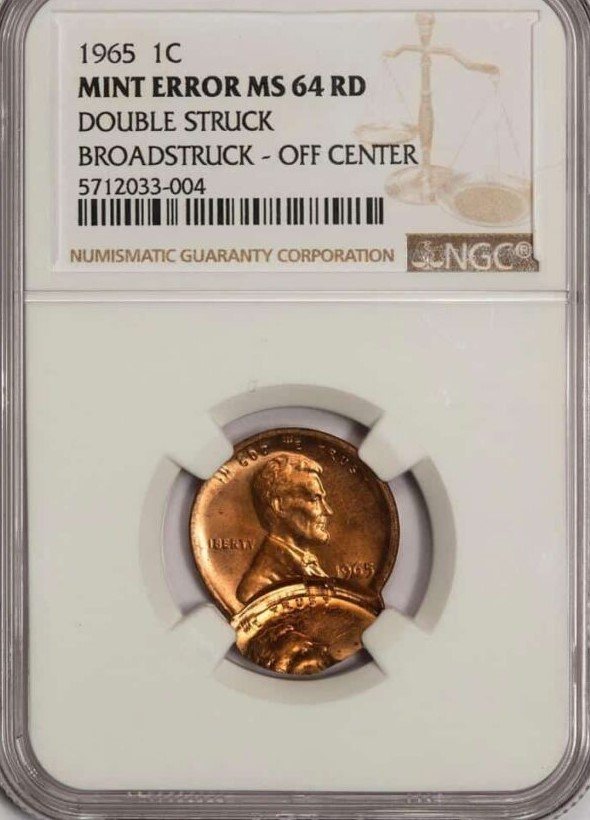
A broadstrike is easy to recognize because the rim on one side of the coin will appear flatter than usual, and the diameter might be slightly wider. This happens because the coin wasn’t confined properly during the striking process, causing it to spread out.
In addition to the broadstrike, this particular coin also has a double strike error. A double strike occurs when the coin is struck more than once. In this case, the second strike was misaligned, meaning the die did not align properly with the planchet. This caused the image from the second strike to overlap or distort with the first strike, resulting in a misaligned and distorted design.
In MS 64 RD (Mint State 64 Red), a broadstrike with a double strike error can increase the coin’s value. For example, such a coin has sold for around $185. The higher the grade and the more severe the error, the more valuable the coin can become.
1965 Penny Clip Error
A clip error occurs when part of the planchet, which is leftover metal from the punching process, doesn’t get melted and recycled properly. Instead, it accidentally gets fed back into the press. This can cause part of the planchet to be missing or curved, resulting in a curved clip on the coin. In some cases, if the metal was near the edge of the sheet, it can cause a straight clip.
In the case of a 1965 Penny Clip Error, the curved clip appears next to the holes in the planchet, affecting the coin’s appearance. These types of errors happen during the blanking process, where the coin is punched out of a larger sheet of metal.
A MS 63 RB (Mint State 63 Red-Brown) 1965 penny with a clip error is usually worth about $20, though the value can increase depending on the severity of the clip and the coin’s grade. More pronounced or unique errors tend to have higher resale values.
1965 Penny Struck on a Defective Planchet Error
A 1965 Penny Struck on a Defective Planchet Error occurs when the planchet (the blank metal disc before it’s struck by the die) is poorly made or has defects in its structure. These defects could include imperfections such as air bubbles, weak areas, or uneven smelting, which can cause the coin to deteriorate or disintegrate during the minting process.
When a defective planchet is struck, the coin may end up with jagged edges or eroded surfaces due to the poor quality of the metal. These defects are the result of the planchet failing to hold its shape under the pressure of the die, leading to a damaged appearance. In some cases, pieces of the coin may even crumble off.
In terms of value, a 2.7g MS 65 RB (Mint State 65 Red-Brown) 1965 penny with a defective planchet error can fetch around $100. The value can fluctuate depending on the extent of the defect and the overall condition of the coin, but it remains a collectible due to the rarity of such errors.
1965 Penny Struck 45% Off-Center on Unusual Planchet
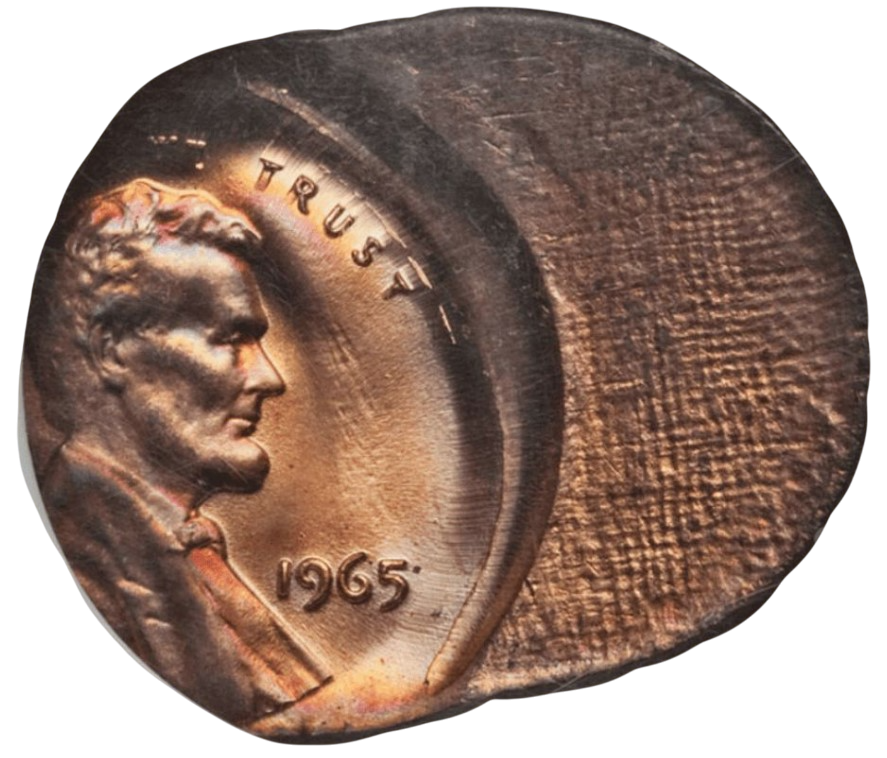
When a coin has multiple errors, the cumulative value can significantly increase, as collectors are often drawn to the rarity and uniqueness of such pieces. In the case of a 1965 Penny with a rough-textured planchet and off-center strike, there are two distinct errors involved that contribute to its increased value:
- Textured Planchet Error: This can happen when a piece of fabric (like cloth or other materials) gets between the blank planchet and the die during the minting process, leaving an unusual texture on the surface of the coin. Another possibility is that the coin was incorrectly annealed, meaning it wasn’t heated or treated correctly, which caused the surface to have a rougher finish.
- Off-Center Strike: This occurs when the planchet doesn’t align properly with the die during the strike, causing the design to be printed off-center. The resulting image on the coin will have portions of the design missing, which makes the coin more visually distinct and rare.
A 1965 Penny with these two errors, graded at MS 67 RB (Mint State 67 Red-Brown), can fetch over $900 due to its unique combination of errors, rarity, and excellent condition. Such coins are highly prized by collectors who seek to add rare error coins to their collections.
1965 Penny Dropped ‘A’ Reverse Error
The 1965 Penny Dropped ‘A’ Reverse Error is a dramatic mint error that occurs when an extra letter or symbol from a previous die is accidentally struck onto the coin. In this case, an additional ‘A’ appears near the steps of the Lincoln Memorial, where FG (the initials of designer Frank Gasparro) would usually be located. This extra letter most likely came from the word “America” and was accidentally re-struck onto the coin during the minting process.
In addition to the dropped ‘A’, the coin also shows a misalignment in the obverse (front) of the coin. The ‘L’ in Liberty is partially sliced off due to the misalignment, which adds another layer of error to the coin’s rarity.
This coin is graded MS 65 RD (Mint State 65 Red) and has a value of around $160 due to its unique minting mistake, the dramatic visibility of the extra letter, and the slight misalignment on the obverse. The dropped ‘A’ is one of the most notable errors that collectors seek out, making it a valuable and rare find.
1965 Penny Multi-Strike Error
The 1965 Penny with Multiple Strikes Error features a drastic example of misalignment during the minting process. Normally, a coin is struck twice to ensure the design is clear and fully visible. However, if the die shifts between strikes, the design may appear doubled or misaligned.
In this case, the second and third strikes were severely misaligned, with the second strike being 50% off-center and the third strike 70% off-center. This causes a very dramatic double-vision effect, where the design overlaps and distorts significantly, creating a unique error.
Graded MS 64 RB (Mint State 64 Red-Brown), this coin was valued at $1,000 due to its extreme misalignment and rarity. Errors like this one are highly sought after by collectors, especially when they involve multiple strikes that create dramatic visual effects. The shifted design makes this coin stand out from standard 1965 pennies, increasing its value among collectors of error coins.
Where to sell your penny?
Now that you know the value of your penny, you might be wondering where to sell it. Don’t worry: here’s a guide to some of the best online platforms where you can easily sell your coins, along with their advantages and disadvantages.
Discover the best platforms for selling coins online (pros and cons).
FAQ About the 1965 Lincoln Penny
1. What is the historical significance of the 1965 Lincoln Penny?
The 1965 Lincoln Penny is a key coin in U.S. history as it marks the beginning of the transition period for U.S. coinage, especially in terms of design and composition. In 1965, the U.S. Mint began using a copper-nickel clad composition for dimes, quarters, and half dollars, which later extended to the penny as well. Although the penny was still made of the traditional copper alloy in 1965, it marked the year of the transition for other denominations, making it historically relevant in the evolution of U.S. coinage.
2. What is the composition of the 1965 Lincoln Penny?
The 1965 Lincoln Penny is made of:
- 95% copper
- 5% tin and zinc
This is the same composition as pennies minted from 1909 to 1982, before the U.S. Mint switched to a copper-plated zinc composition in 1982. Despite changes to other coins in 1965, the penny retained its original copper-based composition for another decade.
3. How many 1965 Lincoln Pennies were minted?
In 1965, the total mintage for the Lincoln Penny was as follows:
- Philadelphia Mint (no mintmark): 1,497,600,000
- Denver Mint (D mintmark): 1,404,360,000
This brings the total mintage for the 1965 Lincoln Penny to 2.9 billion, making it a very common coin in circulation. These numbers reflect the large-scale coin production required to meet the demands of the growing U.S. economy.
4. What is the value of a 1965 Lincoln Penny today?
The value of a 1965 Lincoln Penny varies based on its condition, with high-grade examples being more valuable. Here’s a rough estimate:
| Condition | 1965 (No Mintmark) | 1965-D |
|---|---|---|
| Circulated | $0.01–$0.05 | $0.01–$0.05 |
| Uncirculated (MS60) | ~$0.10–$0.25 | ~$0.10–$0.25 |
| MS63 Red | ~$1–$2 | ~$1–$2 |
| MS65 Red | ~$3–$5 | ~$3–$5 |
| With major errors | Varies ($10–$100+) | Varies ($10–$100+) |
The 1965 penny is widely circulated, and in most cases, it’s worth only its face value in circulated condition. However, coins in high-grade uncirculated (MS-65 or higher) can fetch around $3–$5, depending on their quality. Errors like die cracks or off-center strikes could push the value higher.
5. Are there any rare error varieties in the 1965 Lincoln Penny?
While the 1965 Lincoln Penny doesn’t have any notable design variations, several error varieties can make certain coins more valuable:
- Die cracks: Raised lines or breaks in the die can result in noticeable cracks across the coin’s surface.
- Off-center strikes: When the planchet is not properly aligned in the press, the design can be off-center.
- Clipped planchets: A missing piece from the edge of the coin due to a blanking error.
- BIE error: A die crack between the “B” and “E” in “LIBERTY,” which may look like an “I”.
These errors can increase the value of the coin, especially if it’s in a higher grade.
6. How do I identify a high-grade 1965 Lincoln Penny?
A high-grade 1965 penny should show:
- Sharp, crisp details: The Lincoln portrait and the wheat stalks on the reverse should be clearly defined, without wear.
- Clean surfaces: Minimal abrasions, scratches, or contact marks.
- Strong luster: Coins in uncirculated condition should show a shiny, reflective surface, especially in well-preserved areas.
- Full rims: The coin’s rims should be intact and well-defined, without signs of wear.
If a 1965 penny is graded MS-65 or higher, it should have no visible imperfections and should reflect its original shiny luster.
7. Is the 1965 Lincoln Penny worth collecting?
While the 1965 Lincoln Penny is very common, it still holds some appeal for collectors:
- If you’re assembling a complete set of Lincoln Memorial pennies.
- If you’re interested in error coins, especially if the 1965 penny has notable die cracks, off-center strikes, or other minting errors.
- For those seeking high-grade examples or interesting additions to their collection, uncirculated coins or those with rare mint errors could be worth holding onto.
Though not the most valuable year for the Lincoln Penny series, the 1965 penny can still be of interest to collectors looking to complete sets or find rare varieties.


















































